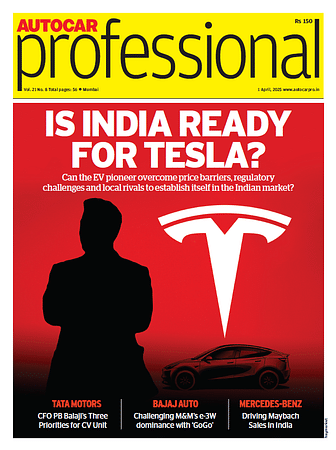Electric 2W sales jump 40% in September, Bajaj Chetak outsells TVS iQube, Ola share falls to 27%
Electric scooter and motorcycle retails rise strongly to 88,156 units in September with the standout news being Bajaj Auto (18,933 Chetaks) surpassing longstanding No. 2 OEM, TVS Motor Co (17,865 iQubes). Market leader Ola Electric hits an 11-month low of 23,965 units and its share is down to 27% from 39% in July. With 9-month sales crossing 799,000 units, the industry is well set to hit the million sales mark for the first time in a calendar year.
September 2024 came and went, the month witnessing strong retail sales of 88,156 electric scooters, motorcycles and mopeds, up 40% year on year (September 2023: 63,184 units). If the four-month EMPS 2024 subsidy scheme, which ended on September 30, had not been extended / subsumed in the form of the new PM E-Drive Scheme, last month’s retail sales would likely have crossed 100,000 units, just as they did in March 2024 when FAME II came to an end and buyers advanced their zero-emission two-wheeler purchases.
 With cumulative 9-month sales of 799,103, the e2W industry is just 48,900 units short of matching CY2023's record 848,003 units and is well set to hit the million-units milestone for the first time in a calendar year.
With cumulative 9-month sales of 799,103, the e2W industry is just 48,900 units short of matching CY2023's record 848,003 units and is well set to hit the million-units milestone for the first time in a calendar year.
On September 11, the government announced the rollout of the PM Electric Drive Revolution in Innovative Vehicle Enhancement (PM E-DRIVE) Scheme' for promotion of electric mobility in the country. The scheme has an outlay of Rs 10,900 crore over a two-year period with subsidy / demand incentives worth Rs 3,679 crore aimed at supporting 24.79 lakh e-two-wheelers, 316,000 e-three-wheelers, and 14,028 electric buses. Passenger vehicles have been left out of the ambit of the PM E-Drive Scheme which runs from October 1, 2024 through to March 31, 2026.
This two-year scheme’s rollout, as well as the fact that the ‘Pitru Paksh’ (from September 17 to October 2) when purchase of new vehicles, among other things, are deferred across India saw September register tepid retail sales.
In the calendar year to date, September 2024 retails are the third highest monthly numbers after March 2024 (137,741 units) and August (87,256 units). Overall retails last month would have been higher given that a slowdown in sales has impacted market leader and volume driver Ola Electric.
The electric two-wheeler segment remains the biggest volume driver of the EV industry in India. In September, it accounted for 59% of total India EV Inc's volumes of 148,539 units, as per data published on the government of India’s Vahan website (as of October 1, 6am).
Let’s take a closer look at each of the top six players, who are the movers and shakers of the e-two-wheeler industry.
 OLA ELECTRIC – September 2024: 23,965 units, up 29% YoY
OLA ELECTRIC – September 2024: 23,965 units, up 29% YoY
Market share: 27%
Jan-Sep 2024: 314,761 units, up 74% YoY (Jan-Sep 2023: 181,271 units)
 The recently listed Ola Electric is having a torrid time, particularly in the past two months. The company and market leader, which averaged monthly sales of 37,695 units for the first seven months of CY2024, saw demand fall sharply month on month in August (26,928 units) and September (23,965 units). This has seen the company’s YoY growth slow down substantially from 105% in June and 112% in July, to 46% in August and 29% in September.
The recently listed Ola Electric is having a torrid time, particularly in the past two months. The company and market leader, which averaged monthly sales of 37,695 units for the first seven months of CY2024, saw demand fall sharply month on month in August (26,928 units) and September (23,965 units). This has seen the company’s YoY growth slow down substantially from 105% in June and 112% in July, to 46% in August and 29% in September.
What’s more, Ola’s September 2024 retails are its lowest monthly sales in 11 months after October 2023’s 23,594 units. This much-reduced sales traction has impacted its market share substantially. Ola’s share of e-two-wheeler retails in September was 27%, down by 11 percentage points from the 38% it commanded in March 2024 and July 2024. In August 2024, Ola’s market share was 31 percent.
Ola had opened CY2024 with 31,785 units (up 75%) in January, hit a high of 52,136 units in March (up 145%) and maintained stellar month-on-month growth right from April through to July until August. Nevertheless, Ola remains well ahead of the competition – its cumulative nine-month sales (314,761 units, up 74%) give it an overall market share of 39%, up from 30% a year ago.
In September, Ola became the first Indian EV OEM to surpass 300,000 unit sales in a calendar year.
In an effort to address service issues, Ola Electric has announced a Network Partner programme aimed at being logistically closer to its customers. As per a September 26 tweet by CEO Bhavish Aggarwal, 625 partners are already in place. This will be expanded to 1,000 by the festive season and to 10,000 by end-2025.
Ola Electric’s mass-market S1 X portfolio is available in three battery configurations (2 kWh, 3 kWh, and 4 kWh), and priced at Rs 69,999, Rs 84,999, and Rs 99,999, respectively. The company has also recently revised the prices of its S1 Pro, S1 Air, and S1 X+ to Rs 129,999, Rs 1,04,999, and Rs 89,999, respectively.
Given the marked decline in monthly sales since August 2024, Ola clearly has to rev up its sales act. Though the No. 2 and No. 3 rivals are some distance away, there’s no denying the fact that Ola’s market share has fallen substantially. Will October with Dussehra and November with Diwali light up demand once again for the company?
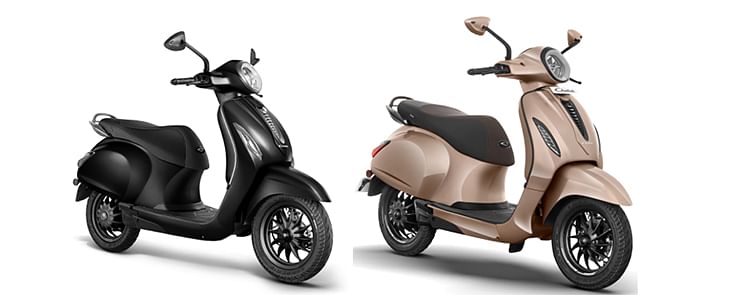 BAJAJ AUTO – September 2024: 18,933 units, up 166% YoY
BAJAJ AUTO – September 2024: 18,933 units, up 166% YoY
Market share: 21.47%
Jan-Sep 2024: 119,759 units, up 195% YoY (Jan-Sep 2023: 40,602 units)
 We have, since over a year ago, been forecasting that Bajaj Auto is the dark horse of both the electric two- and three-wheeler market. In September 2024, the Pune-based company has gone ahead of longstanding No. 2 OEM, TVS Motor Co, selling 18,933 Bajaj Chetaks to TVS’s 17,865 iQubes. In August, Bajaj was just 791 units behind TVS. This gives Bajaj Auto a September market share of 21.47% compared to TVS Motor Co’s 20.26% for last month.
We have, since over a year ago, been forecasting that Bajaj Auto is the dark horse of both the electric two- and three-wheeler market. In September 2024, the Pune-based company has gone ahead of longstanding No. 2 OEM, TVS Motor Co, selling 18,933 Bajaj Chetaks to TVS’s 17,865 iQubes. In August, Bajaj was just 791 units behind TVS. This gives Bajaj Auto a September market share of 21.47% compared to TVS Motor Co’s 20.26% for last month.
Importantly, Bajaj Auto’s YoY speedy rate of growth compared to TVS is helping it to close the gap with the longstanding No. 2 e2W OEM. This is a result of surging consumer demand, ramped-up production of nearly 20,000 units per month and an expanded Chetak retail sales network, billed to be around 1,000 outlets by end-September.
In the January-September 2024 period, Bajaj Auto’s total retails of 119,759 Chetaks are an additional 79,157 units more than the 40,602 units it sold in the year-ago period, up 195% YoY. This stellar performance gives Bajaj Auto a current market share of 15%, a big jump over its 6.66% share in the year-ago period. TVS has a January-September 2024 market share of 18% and it remains to be seen if Bajaj manages to bridge the gap by the end of this year.
In early August, Bajaj Auto launched the Chetak 3201 special edition EV sold only on Amazon, priced at Rs 129,000 (ex-showroom, Bengaluru), with a 136km range which is higher than the top-spec Chetak Premium.
The Chetak 2901, launched in early June at Rs 95,998, is the most affordable of the Chetak line-up and nearly Rs 51,000 cheaper than the top-end variant. The Chetak 2901, which shares its 2.9kWh battery with the mid-spec Chetak Urbane, has successfully taken the battle right into the rivals’ camp – TVS iQube, Ather Rizta S and Ola S1 Air. And the move is playing true with just what Bajaj Auto management planned.
In an analyst call in July, Rakesh Sharma, executive director, Bajaj Auto, said of the Chetak 2901: “It helps us to attack the sub-1 lakh segment, which is almost 50% of the e2-wheeler industry and will help us widen distribution. While our overall market share in Q1 was 12%, it should be noted that we were at 20% plus in the above 1-lakh segment and obviously almost nil in the sub-1 lakh segment. Hence, played the new segment, which is a sub-1 lakh segment and in new geographies, should combine and lift the Chetak business significantly.”
In July 2024, the Bajaj Chetak rode past the 200,000-unit wholesales milestone in the domestic market, news of which Autocar Professional broke. Launched just before the pandemic struck, Bajaj Auto’s first electric scooter took four years to achieve 100,000 sales. The next 100,000-unit dispatches though have come in a scant eight months as a result of new variants and an expanded retail sales network. July 2024’s 20,114 units have been the Chetak’s highest monthly dispatches yet.
 TVS MOTOR CO – September 2024: 17,865 units, up 15% YoY
TVS MOTOR CO – September 2024: 17,865 units, up 15% YoY
Market share: 20.26%
Jan-Sep 2024: 144,354 units, up 22% YoY (Jan-Sep 2023: 118,110 units)
 TVS Motor Co sold 17,865 iQubes in September, which makes for 15% YoY growth (September 2023: 15,523 units). Month-on-month, TVS’s September retails are up 2% month on month (August 2024: 17,441 units) but down 8% on July 2024’s 19,444 units – its best month in the year to date.
TVS Motor Co sold 17,865 iQubes in September, which makes for 15% YoY growth (September 2023: 15,523 units). Month-on-month, TVS’s September retails are up 2% month on month (August 2024: 17,441 units) but down 8% on July 2024’s 19,444 units – its best month in the year to date.
While TVS has been the longstanding No. 2 e-two-wheeler OEM after Ola, it has ceded this rank in September 2024 to a hard-charging Bajaj Auto, which has been registering a higher growth rate. In CY2023, TVS had sold a total of 165,761 iQubes – 93,824 units more than Bajaj Auto’s 71,937 Chetaks. That yawning gap is now stands sizeably reduced in the current calendar year – to 24,595 units.
In an effort to rev up demand and to attract EV buyers surfing for purchases online, the TVS iQube, which was showcased at the Green Plate EV rally on World EV Day (September 9), is now available on Flipkart, priced from Rs 79,999 upwards.
TVS has been freshening up the iQube and in May 2024, two years after the TVS EV got its first refresh, TVS launched more variants, both at the lower and upper end. The iQube line-up now starts with a base variant with a 2.2kWh battery, 75km real-world range, charging time of 2 hours from 0-80 percent with a 950W charger. This base variant is now the most affordable iQube at Rs 94,999. There is also a larger variant with a 3.4kWh battery. Both these models get a 5-inch TFT display with tow and theft alerts and turn-by-turn navigation.
The iQube ST line-up has also expanded to include variants with two capacities – 3.4kWh and 5.1kWh. The iQube ST 3.4 variant (Rs 155,555) has a claimed real-world range of 100km. The range-topping ST 5.1 variant has the largest battery capacity of any Indian electric scooter and TVS claims a real-world range of 150km on a single charge. The iQube ST 5.1 also has a higher 82kph top speed, and the claimed charging time is 4 hours and 18 minutes from 0 to 80 percent. The ST 5.1 gets all the same features as the ST 3.4, but at Rs 185,373, it's the most expensive model in the line-up.
The company, which expects two-wheeler EV sales in India to reach 30% market penetration by CY2025, is targeting a big jump in the contribution of EV sales to its overall volumes over the next two years.
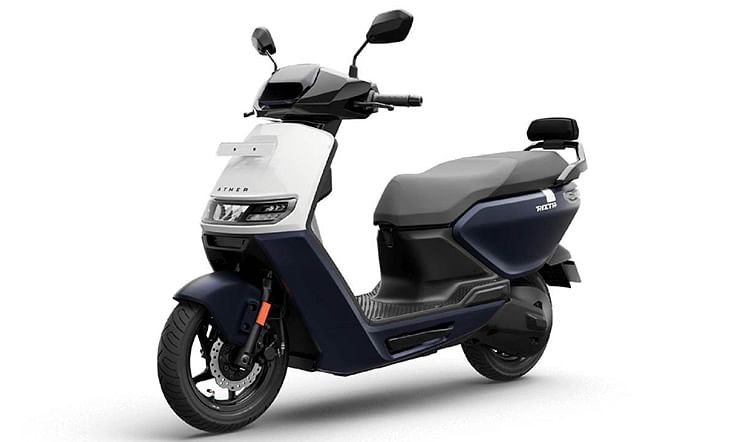 ATHER ENERGY – September 2024: 12,579 units, up 75% YoY
ATHER ENERGY – September 2024: 12,579 units, up 75% YoY
Market share: 14%
Jan-Sep 2024: 85,817 units, up 7% YoY (Jan-Sep 2023: 80,017 units)
 Ather Energy had clocked its best monthly sales in the first six months of FY2025. The company has seen its retails grow month on month right from April 2024 (4,143 units). In September, the smart e-scooter maker sold 12,579 units, up 75% YoY (September 2023: 7,169), which gives it a market share of 14% compared to 11% a year ago.
Ather Energy had clocked its best monthly sales in the first six months of FY2025. The company has seen its retails grow month on month right from April 2024 (4,143 units). In September, the smart e-scooter maker sold 12,579 units, up 75% YoY (September 2023: 7,169), which gives it a market share of 14% compared to 11% a year ago.
Cumulative January-September 2024 retails at 85,817 units are up 7% YoY (January-September 2023: 80,017 units), which gives it a market share of 11% of e2W Inc’s total retails of 799,103 units till end-September.
In April, Ather launched the Rizta family e-scooter (pictured above) at a starting price of Rs 109,999 (Rizta S) through to Rs 149,999 (Rizta Z). While the S version (2.9 kWh battery) has a 123km range, the Z variant (3.7 kWh) has a 160km range. The Rizta’s highlights include the largest two-wheeler seat in India and storage space aplenty.
A reduced sticker price, particularly in view of rivals rolling out affordable EVs, is key to success and Ather has been making moves on this front. In early August, the start-up signed an MoU with Amara Raja Advanced Cell Technologies (ARACT). Amara Raja will collaborate with Ather to develop and supply NMC (Nickel Manganese Cobalt) and LFP (Lithium Iron Phosphate) Lithium-Ion (Li ion) and other advanced chemistry cells, produced locally at ARACT’s upcoming Gigafactory in Divitipally, Telangana.
Tarun Mehta, co-founder and CEO at Ather Energy, said: “We're taking a significant step forward by promoting homegrown cell technology. This will help us optimize costs and enable us to source lithium-ion cells tailored to Ather's specific requirements, further enhancing our ability to innovate and scale efficiently.”
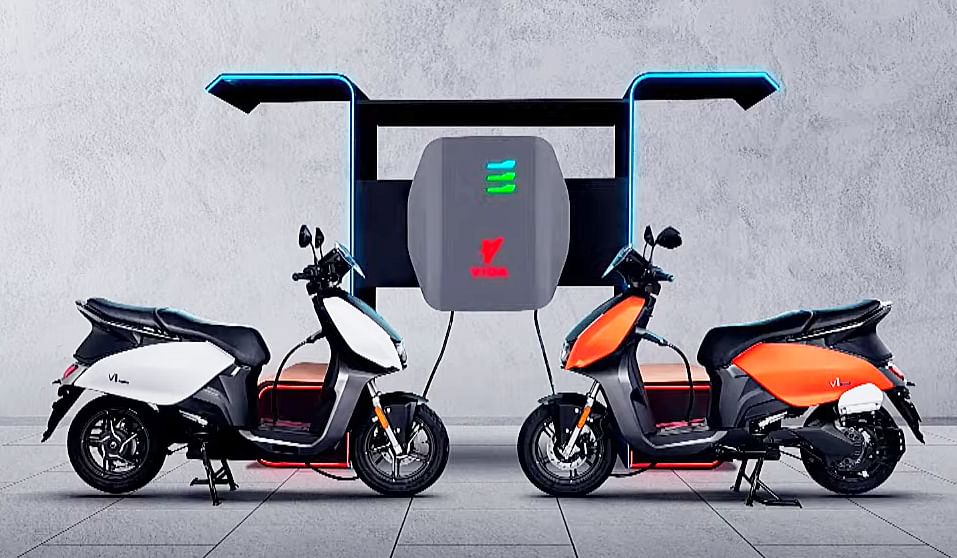 HERO MOTOCORP – September 2024: 4,174 units, up 683% YoY
HERO MOTOCORP – September 2024: 4,174 units, up 683% YoY
Market share: 5%
Jan-Sep 2024: 27,265 units, up 498% YoY (Jan-Sep 2023: 4,558 units)
 The world’s largest two-wheeler manufacturer and the last of the big legacy players to enter the EV market is seeing demand pick up for its Vida brand of e-scooters. The company, which sold 4,174 units in September, clocked 683% YoY growth on a low year-ago base of 533 units. Market share has risen to 4.73% from 0.68% in September 2023.
The world’s largest two-wheeler manufacturer and the last of the big legacy players to enter the EV market is seeing demand pick up for its Vida brand of e-scooters. The company, which sold 4,174 units in September, clocked 683% YoY growth on a low year-ago base of 533 units. Market share has risen to 4.73% from 0.68% in September 2023.
Hero MotoCorp has started scaling up brand presence for Vida and its network now stands at 203 touchpoints comprising 180 dealers across 116 cities. The company, which has the V1 Plus and V1 Pro EVs, plans to expand its portfolio – within the mid- and affordable segment – within FY2025. And it already has around 2,500 charging stations in collaboration with Ather Energy, in which Hero MotoCorp is an early investor.
Like all the leading EV OEMs, Hero MotoCorp too is focusing on reducing product cost. In an earnings conference call on August 14, Niranjan Gupta, CEO, Hero MotoCorp said: “We are working very aggressively, and on the powertrain side, to bring the costs down by technological improvements, by localization, obviously, by bringing scale. You will see that benefit coming out into our further launches as well. You'll see affordable products coming out later this year.”

GREAVES ELECTRIC MOBILITY – September 2024: 2,606 units, down 24% YoY
Market share: 3%
Jan-Sep 2024: 22,244 units, up 85% YoY (Jan-Sep 2023: 12,042 units)
 Greaves Electric Mobility, which was for quite some time ranked fifth, has lost its position to Hero MotoCorp. In September, the company sold a total of 2,606 e-scooters, down 24% YoY (September 2023: 3,447 units). GEM’s latest product is the new Ampere Nexus e-scooter launched on April 30. Its cumulative nine-month sales at 22,244 units are an 85% increase over the 12,042 units in the January-September 2023 period. Its market share currently stands at 3%.
Greaves Electric Mobility, which was for quite some time ranked fifth, has lost its position to Hero MotoCorp. In September, the company sold a total of 2,606 e-scooters, down 24% YoY (September 2023: 3,447 units). GEM’s latest product is the new Ampere Nexus e-scooter launched on April 30. Its cumulative nine-month sales at 22,244 units are an 85% increase over the 12,042 units in the January-September 2023 period. Its market share currently stands at 3%.
Targeted at families, the Ampere Nexus has been designed and developed in-house at the Ranipet facility in Tamil Nadu. Equipped with a 3 kWH LFP battery, the Nexus has a claimed top speed of 93kph and a certified range of 136km. Sold in two variants, prices start at Rs 110,000 (ex-showroom) and go up to Rs 120,000.
Greaves Electric Mobility, like the other five OEMs above it, is also focussing on cost optimisation. In a Q1 FY2025 earnings call on August 13, executive director and CEO K Vijaya Kumar said: “We have been able to make considerable inroads in terms of our costing of key components and products on one side. The other side is broadly we have looked at our cost, sort of a cost rationalization wherein we are getting closer to building our efficiencies much higher than where we were.”
GROWTH OUTLOOK: OEMs TARGET FESTIVE SEASON TO LIGHT UP SALES
Festive October and November are months that all of India Auto Inc is looking forward to. October, with Navratri, beginning early in the month, followed by Dussehra on the 12th and Diwali on the opening day of November, are when OEMs including EV manufacturers, will be pushing the sales envelope through special deals, plenty of advertising and more.
With value-conscious e2W buyers looking to grab bargain buys, online retailer Flipkart’s Big Billion sale (from September 26-October 6) should help accelerate demand. Flipkart, which has an extensive market reach covering over 12,000 pincodes across more than 700 cities in India, has EVs from Ola, TVS, Bajaj Auto and Hero MotoCorp on offer on its platform, and at sizeable discounts.
Furthermore, with the PM E-Drive subsidy scheme now in place, there is ample clarity for buyers and as a result both October and November should ideally see 100,000-plus retails for the e-two-wheeler segment. Of top six OEMs, three – Ola, Bajaj Auto and Hero MotoCorp – have already surpassed their entire CY2023 retails in the first nine months of CY2024 itself. TVS Motor Co needs to sell an additional 22,676 units to surpass its CY2023 retails of 166,579 units. Ather, which registered sales of 104,274 e-scooters in CY2023, needs to sell another 18,457 units in the next three months to surpass that figure. Greaves Electric Mobility, which has sold 22,244 units between January-September 2024, will soon ride past its CY2023 total of 22,999 units.
INDIA E2W INC TO SURPASS RECORD CY2023 SALES IN OCTOBER, AND A MILLION UNITS IN 2024
October 2024 will see India E2-Wheeler Inc ride past the industry’s record CY2023’s retail sales of 848,003 units. At the end of September, with cumulative January-September sales of 799,103 units, the difference was just 48,9009 units . . . which will easily be achieved in the first fortnight of festive October.
That’s not all. Given the current momentum, and the long-term wallet-friendly USP of an EV when compared to the high price of petrol, which currently costs Rs 103.44 a litre in Mumbai (on October 1), along with the growing EV charging infrastructure across the country, total 12-month sales should hit the million-units mark for the first time in a calendar year in CY2024.
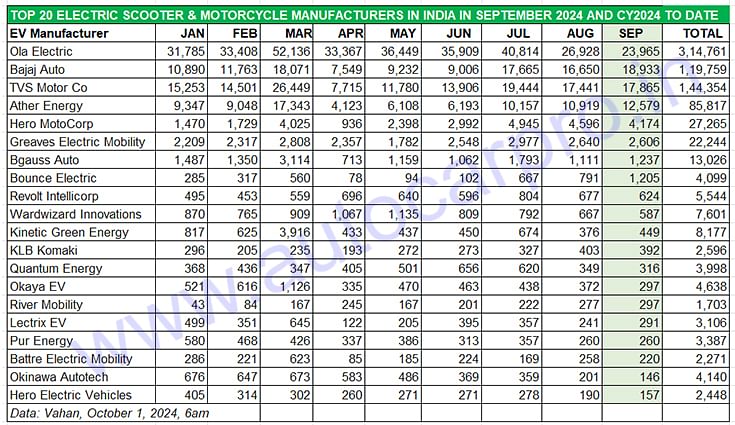
RELATED ARTICLES
Exclusive: Maruti Fronx is first Nexa SUV to hit 300,000 sales
Baleno-based Maruti Fronx becomes the first premium SUV from the Nexa channel to achieve cumulative sales of 300,000 uni...
Scorpio and 3XO command 48% share of record Mahindra SUV sales in FY2025
While the Scorpio N and Classic sold 164,842 units and an additional 23,380 units YoY for a 30% share of M&M’s record sa...
Mahindra produces 8,303 electric-origin SUVs in Q4 FY25, dispatches 8,047 units to dealers
The all-electric XEV 9e and BE 6 accounted for 5% of Mahindra & Mahindra’s wholesales of 149,127 SUVs in January-March 2...






 01 Oct 2024
01 Oct 2024
 35582 Views
35582 Views





 Autocar Professional Bureau
Autocar Professional Bureau



